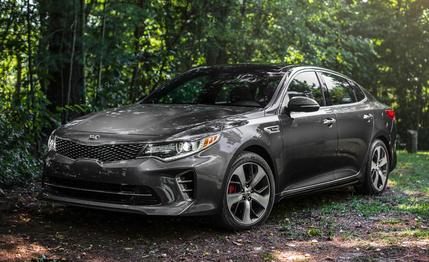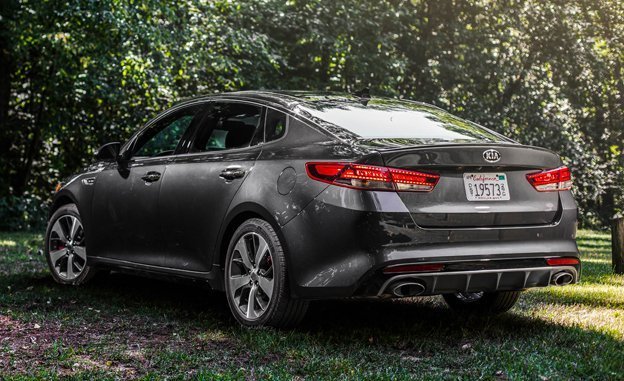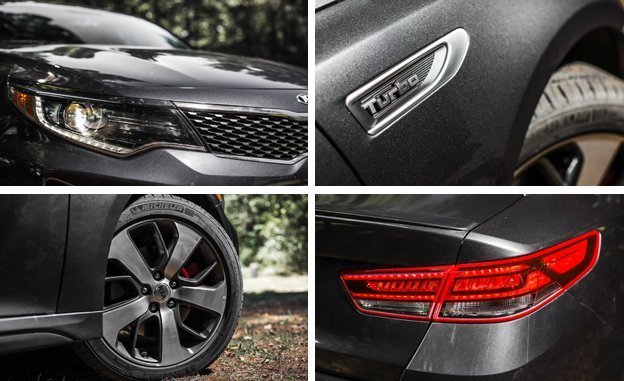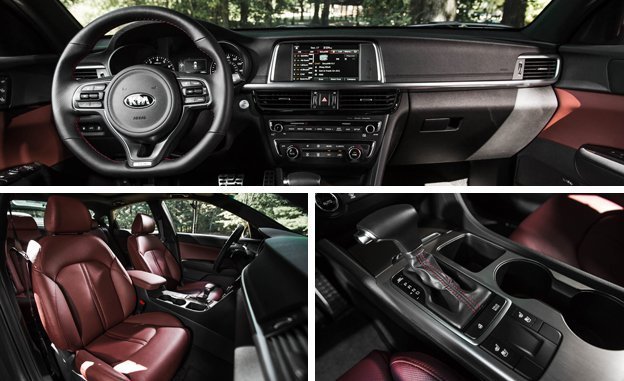
 Instrumented Test
Instrumented Test
The redesigned 2016 Kia Optima has just gone on sale, rocking the expressive styling we’ve admired since its debut at the New York auto show earlier this year. Even in this rational, mainstream family-sedan segment, styling still sells cars, and the wonders design chief Peter Schreyer has been working at Kia for nearly a decade have buyers looking at the Korean brand with less skeptical eyes.
That Kia’s chassis engineering has improved at least as dramatically as its cars’ styling finds the brand near the top of quality rankings and surging on the sales charts. In this hypercompetitive market segment, none of the players presents a static target waiting for Kia to come take away their sales—the Honda Accord that made our 10Best list in 2015, the delight-filled Mazda 6, the Volkswagen Passat, and the Nissan Altima are all upgraded for 2016. So, despite the improvements, Kia opted not to increase prices for the new car. It did add a lot of new optional gear, though.


Including some of these options, the sticker for our test car ran up beyond $38,000. An SX 2.0T, our review car represents the second-highest among five trim levels. Fresh off the assembly line in West Point, Georgia, it was such an early example that, although it was equipped with the $2700 Launch Edition package of options (specific 18-inch wheels, panoramic sunroof, and Harman/Kardon audio upgrade), it wore the wrong paint—all Launch Editions are Snow White Pearl while this car was Platinum Graphite.
From a drivetrain standpoint, the Optima’s freshest element isn’t seen here, either: The LX 1.6T employs a new 1.6-liter turbo four-cylinder coupled to a seven-speed dual-clutch automatic transmission. Compared with the Optima’s standard 185-hp 2.4-liter four-cylinder and six-speed automatic, the smaller 178-hp engine offers more torque (195 lb-ft) and promises better fuel economy (28/39 mpg city/highway EPA ratings). Our SX had the 2.0-liter turbo, about which there’s also some news. As it did at Hyundai last year in the Optima’s platform-mate, the Sonata, this engine took a hit in its power rating in the course of being tuned for more refined behavior. It’s now pegged at 245 horsepower rather than 274. A smaller turbo that spools up more quickly helps deliver the 260 lb-ft of maximum torque (down 9 lb-ft) 300-rpm earlier and across a wider band. It’s not a bad decision, but Kia marketers can no longer claim to approach the power of those competitors (Honda, VW, Nissan, and the Toyota Camry) that still offer a V-6 in their family sedan.
In normal driving, the retuned 2.0-liter turbo mated to the standard six-speed automatic still feels plenty strong for this class and delivers the thrust in a more linear and predictable fashion. It’s also a heap quieter, registering only 71 decibels at wide-open throttle, 4 dB quieter than our test of the previous model with this engine. This car at wide-open throttle was as quiet as the earlier one was cruising on the freeway. That’s not all down to the engine—Kia also stiffened the chassis and retuned the suspension to reduce NVH—but it’s all in keeping with the company’s aim to eliminate the rapidly evaporating criticism that Korean cars fall short on refinement.


This revised 2.0-liter lacks the explosive burst of power up beyond 5000 rpm that enthusiast drivers enjoyed previously, but it’s doubtful many Optima owners often experienced it. Even in the 2016 model, peak power is most evident if the driver chooses the quicker throttle action and more aggressive shift program of Sport mode (other choices are Normal and Eco). The manual shift paddles behind the steering wheel are unrewarding to toggle, being the cheesiest plastic bits in an otherwise impressive interior, and the resulting shifts are mushy. We wish Kia offered the dual-clutch with this engine or, even better, a manual transmission like those you can still get in the Honda and Mazda sedans that are our current favorites in the segment.
Track numbers show little performance degradation compared with the previous car. We got to 60 mph in 6.8 seconds, or 0.4-second longer than it took in the older car, but the gap had shrunk to only 0.2 second and 2 mph in the quarter-mile. Any 60-mph time of less than 7.0 seconds still ranks near the top of this segment. And we recorded 22 mpg—spot-on the EPA’s city rating—with this car versus 20 in the previous generation.
Kia says it also worked to improve handling response by stiffening the chassis with more high-strength steel and adhesives, and it mounts the electric-power-steering motor directly to the rack in the SX and SXL models as opposed to the column-mounted approach in other trim levels. Subjectively, this Optima turns into corners more crisply while the ride also improves, transmitting fewer disturbances to the cabin even with the biggest wheel option. The steering feels above average in a lackluster class, failing to send feedback to your fingertips but being properly weighted and predictable. We saw 0.84 g on our skidpad. We couldn’t perform that test on the previous car due to inclement weather but an Optima EX that placed third in a six-way comparison saw 0.80 g. This car rode on Michelin Primacy MXM4 tires, which we’re more used to seeing on entry-luxury cars. The 174-foot stopping distance from 70 mph is merely average, but the pedal felt good and there was no fade over repeated stops.


Even without the richer nappa leather it was supposed to get, the interior on this example looked terrific, with real metal trim on the doors and dash. We’re supposed to make allowances on fit-and-finish of preproduction prototypes, but this example would have put some $50,000 cars to shame on that score. The redesigned dashboard is divided into upper “display” and lower “control” regions and that mostly works well, but the distinction is blurred by the 8.0-inch touch screen that functions as both a display and a control system. This is angled slightly toward the driver, which we found an aid to reading and using it while driving solo, but it annoyed one passenger whom we asked to perform navigation and infotainment tasks. The rectilinear dash design looks almost minimalist compared to some of the swoopy shapes we’ve been seeing lately, and that puts a big flat slab in front of the passenger. Some of us thought it looked clean and tidy, while others found it plain and boring.
There’s nothing minimalist about the array of buttons, knobs, controls, and gizmos. This car had a $4800 Premium Technology package, which includes adaptive cruise control, front-collision warning, an electronic parking brake, lane-departure warning, and autonomous emergency braking. A buyer willing to live without those, or the Launch Edition trimmings, could drive off in an SX priced much closer to $30,000. And it would hardly be a penalty box thanks to the long list of standard equipment, which reflects Kia’s decision that it need not offer the lowest price in any segment (its original strength) if it can offer more kit than competing models at the same price. The new Optima looks primed to continue gaining sales, especially as more people figure out they can get the same goodness found in this car at a lower price point.